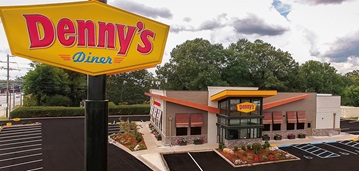SDN: Powering the Next Generation of QSR Networks

The quick-service restaurant industry is reinventing itself through its committed approach to customer experience, powered in large part by technology that has spurred innovation and competition. Customers today routinely take advantage of – and expect – free Wi-Fi, self-service kiosks, mobile payment options, order-ahead capabilities, and rewards programs that are available through easy-to-use apps that also rack up loyalty points with each purchase. These and other technology-centric perks are fundamentally changing the dining experience in QSRs and other types of casual dining restaurants.
According to the National Restaurant Association’s 2017 Industry Outlook, 80 percent of millennials have used restaurant Wi-Fi in the past 12 months, and 20 percent of consumers said they would rather use technology than interact with staff.[1] Couple that with the fact that 9 in 10 consumers say they enjoy going to restaurants[2], and it’s easy to see how technology has become an integral part of QSRs’ recipe for success.
The influx of technology—both customer-facing and operational— into the QSR environment today demands high-capacity, high-bandwidth network solutions to operate at and sustain peak efficiency. It’s no longer enough to simply install a Wi-Fi router and call it a day; customers compare QSR technology services to the experiences they are used to at home and elsewhere. Meeting these expectations requires constant connectivity and the ability to handle peak traffic loads with ease. From the analytics engines that power personalized marketing campaigns to digital signage boards that adapt on the fly to reflect pricing and inventory changes, restaurant technologies need networks that are highly available and highly efficient.
To meet the needs of today’s technologies and prepare for the future, networks are undergoing a transformation. The proprietary hardware of yesterday is being replaced by open technologies that are not only less expensive, but also customizable to meet multiple needs and support new applications and services. Software-defined networking (SDN) is helping make this possible.
Regardless of their size or industry, organizations are adopting SDN to meet the needs of increasingly bandwidth-intensive applications and services for customers and employees alike. QSRs and other types of restaurants, too, are realizing the benefits of using SDN to build better networks at a lower cost.
SDN: A Quick Primer
The Open Networking Foundation (ONF), a technology organization dedicated to furthering the adoption of software-defined networking, defines SDN as “… an emerging architecture that is dynamic, manageable, cost-effective and adaptable, making it ideal for the high-bandwidth, dynamic nature of today's applications. This architecture decouples the network control and forwarding functions, enabling the network control to become directly programmable and the underlying infrastructure to be abstracted for applications and network services.”[3] Programmability, agility, and vendor-neutrality are just some of the benefits of SDN.
SDN provides the platform to increase the efficiency and intelligence of a network, while also reducing that network’s complexity. The myriad benefits of SDN all serve to accommodate the next-generation services many organizations want to adopt or have already adopted, including cloud computing and virtualization.
According to research from TBR, SDN will compose nearly 40 percent of global enterprise network infrastructure revenue, roughly $12.7 billion, by 2020.[4] Allied Market Research, meanwhile, forecasts that the global SDN market will reach $132.9 billion by 2022, with a compound annual growth rate of 47 percent between 2016 and 2022.[5]
Benefits of Software-Defined Networking
With their emphasis on customer service, QSRs have much to gain from SDN technology. As cloud computing, the Internet of Things, and other next-generation technologies further shape how restaurants engage and interact with their customers, SDN will position QSRs to address key challenges associated with ensuring that data-intensive, connectivity-reliant technologies are supported by a resilient, high-efficiency, and cost-effective infrastructure.
In particular, SDN offers benefits of interest to QSRs, including:
Centralized provisioning and management: Software-defined networking separates the intelligence of the network from the data, enabling network administrators to manage the devices on a network from one central site. Using an SDN controller, IT administrators at corporate headquarters can provision and manage all of the company’s network resources in all locations, including franchise facilities, from one central control panel – which ensures that all devices and applications on the network are up-to-date. What’s more, application, security, and software updates can be pushed out to all network devices in one stroke, ensuring all network elements remain current.
For example, digital signage at a QSR’s franchise locations can be managed centrally at corporate headquarters, to instantly reflect and react to changes due to customer demand, inventory, or other environmental factors. Likewise, updates to cash register systems can be pushed out to reflect new pricing or new menu items.
Better security control: Central management also benefits the security of the network, which is top of mind for every company, since data breaches can compromise customer privacy and proprietary business information. SDN controllers also can act as a central point of control to distribute security and policy information consistently. As more devices are added to networks, ensuring each has the proper security controls can become challenging. By centralizing the management of security for all devices on the network, however, QSRs can ensure their networks—and the devices connected to them—are secure.
Lower operating costs: Because many routine network administration issues can be centralized and automated using software-defined networking, QSRs that adopt SDN no longer need an onsite IT manager and thus can save on manpower costs. What’s more, central management means tasks are completed more quickly and with a lower risk of error, which can further reduce network administration overhead.
Lower hardware costs: The open-source nature of SDN enables companies to repurpose their existing hardware for software-defined networking, as the intelligence lives at the controller. These companies’ current hardware becomes, in essence, an assortment of white boxes that simply move traffic. Not having to invest in a whole new infrastructure helps organizations save money and gain a smooth path for migration.
Application performance control: Centralized management also gives organizations control over data traffic, which can help ensure that applications perform as expected. More critical data, such as sales information for franchise locations, can be prioritized for immediate delivery over applications that are not considered mission-critical. The ability to shape and control data traffic ensures the right services are delivered first.
SD-WAN: Bringing More Intelligence to the WAN
Due to the nature of competition and innovation occurring in the restaurant industry, QSRs are an industry with a ripe use case for SD-WAN. SD-WAN separates the data plane from the intelligence, enabling corporate headquarters to manage the networks that connect each location. SD-WAN technologies can provide a level of visibility across the network that doesn’t exist in traditional WANs, enabling smarter, more efficient application level routing of traffic across a distributed enterprise.
The application-aware nature of SD-WAN enables IT administrators to determine the most intelligent path for their applications, and to push, manage, and update policies for optimal application and network performance across their business. What’s more, SD-WAN is centrally managed, so all provisioning and changes to the network and applications are done from one location, reducing the amount of time and manpower necessary to manage the network. Plus, all security policies are managed centrally, enabling IT administrators to implement security updates to all devices on the entire network quickly and easily.
SD-WAN overlays traditional or hybrid WAN infrastructures, and automatically locates the software or hardware nodes at each location and in the cloud. Then, based on predefined policies, traffic is steered along the best path to ensure data via the fastest route.
Examples of SDN Use in QSRs
SDN is proving its value in a number of vertical markets, and the QSR industry is no exception. As more companies invest in and harness the power of big data analytics, software-defined networking is providing a fast conduit to collect, analyze, and act upon the insights culled from the data. Valuable business information, such as which menu items are most likely to be ordered together or which menu items sell better on certain days, can help restaurateurs better manage both front-end and back-end operations. Menu items can be bundled into meals, which can increase upsell opportunities, while inventory can be managed at a more granular level. Such information also can help managers and owners better forecast and be better prepared for days of heavier customer traffic.
Marketing efforts, too, can benefit from the speed and intelligence afforded by software-defined networking. Mobile apps, geofencing, and location-based marketing are more effective when data is collected and distributed quickly—coupons, promotions, and other incentives pushed to the customer at just the right time increases the likelihood of the customer choosing the restaurant.
SDN in QSRs: The Network Is the Key
Software-defined networking holds the promise of greater efficiencies at lower operating costs. However, as with any other technology, the network is critical in delivering on that promise. QSRs and other types of restaurants need a highly reliable, secure, and flexible network. SDN and SD-WAN technologies can complement their existing networks, delivering unprecedented network visibility and centralized control to optimize network and application performance and security for all locations. The ability to combine SDN with high-speed broadband delivers a new, cost-effective business model for adding broadband, and creating intelligent IP VPN connections to accommodate the growing need for bandwidth to deliver more customer-centric services.
Comprehensive and uncompromised connectivity is key to ensuring QSRs can serve their customers in the way that today’s technology-centric customers have come to expect. Cloud computing, big data analytics, mobility, the Internet of Things, and other next-generation technologies are enabling true digital business transformation in the restaurant industry. A solid and flexible network foundation is imperative.
Conclusion
Delivering uncompromised connectivity can be costly and complex for many QSRs, especially franchise locations. Smart organizations work with a network service provider that can deliver both the SD-WAN and high-speed broadband connections that are essential to meet evolving customer-centric requirements.
The emphasis on technology in providing a truly customer-focused dining experience is forcing many QSRs to re-evaluate and transform their legacy networks. Software-defined networks hold the promise of lower cost, greater flexibility, and easier management for organizations of all size, while supporting the high-bandwidth, dynamic nature of applications today and in the future.
View the PDF.
[1] “2017 Restaurant Industry Pocket Factbook,” National Restaurant Association, February 2017, http://www.restaurant.org/Downloads/PDFs/News-Research/Pocket_Factbook_FEB_2017-FINAL.pdf
[2] Ibid
[3] “Software-Defined Networking (SDN) Definition,” Open Networking Foundation https://www.opennetworking.org/sdn-resources/sdn-definition
[4] “Enterprise SDN Market Landscape,” research report, TBR, November 2016, http://tbri.com/analyst-perspectives/press-releases/pgView.cfm?release=13890
[5] “SDN Market Report,” research report, Allied Market Research, June 2016, https://www.alliedmarketresearch.com/software-defined-data-center-market
With their emphasis on customer service, the quick-service restaurant industry has much to gain from SDN technology.
Locked Content
Click on the button below to get access
Unlock NowOr sign in to access all content on Comcast Business Community
Resource Center
Learn how Comcast Business can help
keep you ready for what's next.











